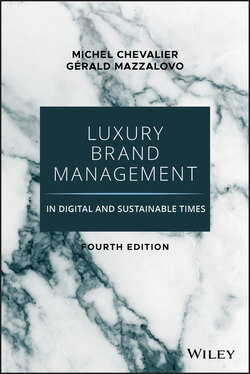Читать книгу Luxury Brand Management in Digital and Sustainable Times - Michel Chevalier - Страница 37
Conclusion on the Notion of Luxury
ОглавлениеSeveral lessons can be drawn from this very general overview of the different dimensions of luxury.
Luxury became first an elitist and rewarding practice and then, under the impulse of brands, a market that is submitted to an ever-increasing segmentation. Today, there is not one luxury but many of them, each aimed at a specific category of population, characterized by their purchasing power, social group codes, and specific ambitions. We must get used to an acceptance of the term much broader than in the past. It has now become necessary to clarify, each time, what sort of luxury we want to talk about.
Despite their many manifestations, luxuries provide some common benefits. Luxury divides and unites at the same time; it produces distinction under the banner of brands; it blurs (with the exception of very exclusive luxury) the line between discomfort and opulence, but it promises to all social layers to escape the mass by consuming better (in the case of true luxury) or just a little better (in the case of intermediate luxury) than our peers. Luxury re-creates tribes, groups of the happy few being in the sharing of practical or symbolic qualities. This may be the excellence of a product, originality, the newness of a style, or, more informally, the manifestation of a certain state of mind. Luxury should both make us dream (logic of desire) and comfort us by communicating sensual or emotional satisfactions (logic of pleasure).
Luxury works in opposition to a norm, to a convention shared by the greatest number—the “vulgar,” in the etymological sense of the term. In this sense, the lapidary definition of Coco Chanel perfectly expresses its essence: “Luxury is the opposite of vulgarity.”
The challenge for luxury brands is going to be defining what kind of convention it wants to be distinguished from and by which means it will show its differences. From there follows its positioning and its strategy. Authentic and discreet luxury follows the saying that “money does not matter.” It is from the mercantile norms that it intends to deviate. Economic issues are occulted in favor of the affirmation of perennial values. Its eccentricity will be modeled on the axes of aesthetic research, qualitative perfection, rejection of the ephemeral, in short, of an investment of exception. For intermediate luxury, the norms it dissociates from are those of a degraded version of daily life—the ordinary—from which it promises to escape in a fugitive whiff of distinction and fantasy, as in role playing.
There are diverse means by which luxury is distinguished: the natural, the original, the exceptional, the referential, and the authority, suggest Gilmore and Pine. But other ways can be mentioned: lifestyles, cultures, know-how (such as very high quality crafts), and technologies (e.g., it just went bankrupt the American manufacturer Tesla Motors, which aspires to become a luxury brand of electric automobiles) are all potential sources to establish true luxury brands … as long as they offer us extraordinary and exceptional experiences and continue to make us dream.
And finally, luxury is anthropological. It is a constant and natural hedonistic research of human beings of all time.
